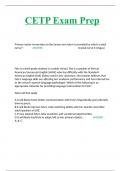Samenvatting
Summary Contract and Tort Law
- Vak
- Instelling
Includes all necessary case law and Articles from the DCFR; each week is split into two parts [case law and legislation] to make it easier to follow since in the exam the questions are based solely on the DCFR or case law [not mixed application.] I got a grade 9 in the exam while using these notes ...
[Meer zien]












